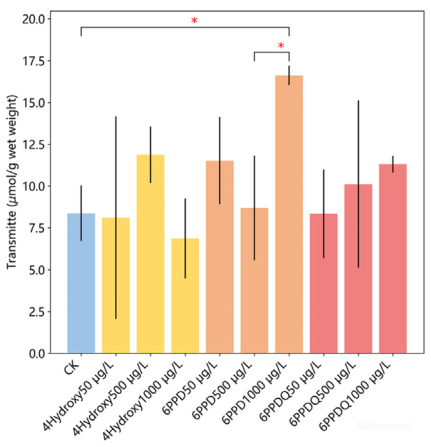γ-Aminobutyric Acid (GABA) Colorimetric Assay Kit
SKU: E-BC-K852-M-96
To better serve you, we would like to discuss your specific requirement.
Please Contact Us for a quote.
γ-Aminobutyric Acid (GABA) Colorimetric Assay Kit
| SKU # | E-BC-K852-M |
| Detection Instrument | Microplate reader (630-650 nm, optimum wavelength: 640 nm) |
|
Detection method |
Colorimetric method |
Product Details
Properties
| Sample type | Plant and animal tissue |
| Sensitivity | 0.06 μmol/mL |
| Detection range | 0.06–10.0 μmol/mL |
| Detection method | Colorimetric method |
| Assay type | Quantitative |
| Assay time | 40 min |
| Precision | Average inter-assay CV: 6.800% | Average intra-assay CV: 4% |
| Other instruments required | Test tube, Micropipettor, Vortex mixer, Centrifuge, Water bath (95℃) |
| Storage | 2-8℃ |
| Valid period | 12 months |
Images
JW Ji et al investigate the eco-toxicity of 6PPD and its neurotoxicity. Concentration of γ-aminobutyric acid (GABA) of zebrafish brain was determined using GABA colorimetric assay kit (E-BC-K852-M).

Exposure of 6PPD significantly increased the concentration of GABA in zebrafish brain. (P<0.05)
Dilution of Sample
It is recommended to take 2~3 samples with expected large difference to do pre-experiment before formal experiment and dilute the sample according to the result of the pre-experiment and the detection range (0.06–10.0 μmol/mL).
The recommended dilution factor for different samples is as follows (for reference only):
| Sample type | Dilution factor |
| 10% Epipremnum aureum tissue homogenization | 1 |
| 10% Green pepper tissue homogenization | 1 |
| 10% Chinese yam tissue homogenization | 1 |
| 10% Rat heart tissue homogenization | 1 |
| 10% Rat liver tissue homogenization | 1 |
| 10% Rat kidney tissue homogenization | 1 |
Note: The diluent is reagent 1.
Detection Principle
Phenol and sodium hypochlorite react with GABA to produce a blue-green product, which has maximum absorbance at 640 nm. GABA content can be calculated with the absorbance at 640 nm.
Kit Components & Storage
| Item | Component | Size 1(48 T) | Size 2(96 T) | Storage |
| Reagent 1 | Extracting Solution |
60 mL × 1 vial | 60 mL × 2 vials | 2-8℃, 12 months |
| Reagent 2 | Buffer Solution | 3 mL × 1 vial | 6 mL × 1 vial | 2-8℃, 12 months |
| Reagent 3 | Chromogenic Agent A | 2.4 mL × 1 vial | 4.8 mL × 1 vial | 2-8℃, 12 months, shading light |
| Reagent 4 | Chromogenic Agent B | 3.6 mL × 1 vial | 7.2 mL × 1 vial | 2-8℃, 12 months, shading light |
| Reagent 5 | Supplementary Solution | 12 mL × 1 vial | 24 mL × 1 vial | 2-8℃, 12 months |
| Reagent 6 | 10 μmol/mL GABA Standard | 1.6 mL × 1 vial | 1.6 mL × 2 vials | 2-8℃, 12 months |
| Microplate | 96 wells | No requirement | ||
| Plate Sealer | 2 pieces | |||
Note: The reagents must be stored strictly according to the preservation conditions in the above table. The reagents in different kits cannot be mixed with each other. For a small volume of reagents, please centrifuge before use, so as not to obtain sufficient amount of reagents.
Technical Data:
Parameter:
Intra-assay Precision
Three rat heart tissue samples were assayed in replicates of 20 to determine precision within an assay (CV = Coefficient of Variation)
| Parameters | Sample 1 | Sample 2 | Sample 3 |
| Mean (μmol/mL) | 0.64 | 2.60 | 7.20 |
| %CV | 4.3 | 3.9 | 3.8 |
Inter-assay Precision
Three rat heart tissue samples were assayed 20 times in duplicate by three operators to determine precision between assays.
| Parameters | Sample 1 | Sample 2 | Sample 3 |
| Mean (μmol/mL) | 0.64 | 2.60 | 7.20 |
| %CV | 6.6 | 7.2 | 6.6 |
Recovery
Take three samples of high concentration, middle concentration and low concentration to test the samples of each concentration for 6 times parallelly to get the average recovery rate of 96%.
| Standard 1 | Standard 2 | Standard 3 | |
| Expected Conc. (μmol/mL) | 1.5 | 4.6 | 8.5 |
| Observed Conc. (μmol/mL) | 1.5 | 4.4 | 8.1 |
| Recovery rate(%) | 98 | 95 | 95 |
Sensitivity
The analytical sensitivity of the assay is 0.06 μmol/mL. This was determined by adding two standard deviations to the mean O.D. obtained when the zero standard was assayed 20 times, and calculating the corresponding concentration.
Standard Curve
As the OD value of the standard curve may vary according to the conditions of the actual assay performance (e.g. operator, pipetting technique or temperature effects), so the standard curve and data are provided as below for reference only:
| Concentration (μmol/mL) | 0 | 1.0 | 2.0 | 4.0 | 5.0 | 7.0 | 9.0 | 10.0 |
| Average OD | 0.043 | 0.079 | 0.117 | 0.179 | 0.218 | 0.295 | 0.349 | 0.379 |
| Absoluted OD | 0.000 | 0.037 | 0.074 | 0.136 | 0.175 | 0.253 | 0.307 | 0.336 |



